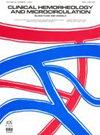Consistency of left ventricular ejection fraction measurements in the early time course of STEMI
IF 2.1
4区 医学
Q3 HEMATOLOGY
引用次数: 0
Abstract
Background: Assessment of left ventricular (LV) function and volume after ST-segment elevation myocardial infarction (STEMI) is recommended to guide clinical decision within and after hospitalization. Early after STEMI, initial LV reshaping and hypokinesia may affect analysis of LV function. A comparative evaluation of left ventricular ejection fraction (LVEF) and stroke volume (SV) by different imaging modalities to assess LV function early after STEMI has not been performed so far. Methods: LV function was assessed by LVEF and SV using serial imaging within 24h and 5 days after STEMI with cineventriculography (CVG), 2-dimensional echocardiography (2DE), 2D and 3D cardiovascular magnetic resonance (2D/3D) in 82 patients. Respective parameters were compared between modalities and to 3D gold standard CMR. Results: 2D analyses of LVEF using CVG and 2DE as well as 2D CMR yielded uniform results within 24h and 5 days of STEMI. SV assessment between CVG and 2DE at day 1 after STEMI was comparable, whereas values for SV were higher using 2D CMR on all occasions (p<0.01 all). This was due to higher LVEDV measurements. LVEF by 2D versus 3D CMR was comparable, 3D CMR yielded consistently higher volumetric values. This was not influenced by infarct location or infarct size. Conclusions Early after STEMI, 2D analysis of LVEF yielded robust results across all imaging techniques implying that CVG, 2DE, and 2D CMR can be used interchangeably in this setting. SV measurements to assess cardiac function differed substantially between imaging techniques due to higher intermodality-differences of absolute volumetric measurements.STEMI早期左心室射血分数测量的一致性
背景:建议评估ST段抬高型心肌梗死(STEMI)后的左心室(LV)功能和容量,以指导住院期间和住院后的临床决策。STEMI后早期,最初的左心室重塑和运动功能减退可能影响左心室功能的分析。到目前为止,还没有通过不同的成像方式对左心室射血分数(LVEF)和射血容量(SV)进行比较评估,以评估STEMI后早期的左心室功能。方法:82例ST段抬高型心肌梗死(STEMI)患者在术后24小时和5天内,采用连续成像技术,分别用电影心室造影(CVG)、二维超声心动图(2DE)、二维和三维心血管磁共振(2D/3D)对左心室功能进行评估。将模态之间的各个参数与3D金标准CMR进行比较。结果:在STEMI发生后24小时和5天内,使用CVG和2DE以及2D CMR对LVEF进行2D分析,结果一致。STEMI后第1天CVG和2DE之间的SV评估具有可比性,而使用2D CMR的SV值在所有情况下都更高(p均<0.01)。这是由于LVEDV测量值较高。2D和3D CMR的LVEF具有可比性,3D CMR产生的体积值始终较高。这不受梗死部位或梗死面积的影响。结论STEMI后早期,LVEF的2D分析在所有成像技术中都产生了稳健的结果,这意味着CVG、2DE和2D CMR可以在这种情况下互换使用。由于绝对体积测量的互调差异较大,评估心脏功能的SV测量在成像技术之间存在显著差异。
本文章由计算机程序翻译,如有差异,请以英文原文为准。
求助全文
约1分钟内获得全文
求助全文
来源期刊
CiteScore
4.30
自引率
33.30%
发文量
170
期刊介绍:
Clinical Hemorheology and Microcirculation, a peer-reviewed international scientific journal, serves as an aid to understanding the flow properties of blood and the relationship to normal and abnormal physiology. The rapidly expanding science of hemorheology concerns blood, its components and the blood vessels with which blood interacts. It includes perihemorheology, i.e., the rheology of fluid and structures in the perivascular and interstitial spaces as well as the lymphatic system. The clinical aspects include pathogenesis, symptomatology and diagnostic methods, and the fields of prophylaxis and therapy in all branches of medicine and surgery, pharmacology and drug research.
The endeavour of the Editors-in-Chief and publishers of Clinical Hemorheology and Microcirculation is to bring together contributions from those working in various fields related to blood flow all over the world. The editors of Clinical Hemorheology and Microcirculation are from those countries in Europe, Asia, Australia and America where appreciable work in clinical hemorheology and microcirculation is being carried out. Each editor takes responsibility to decide on the acceptance of a manuscript. He is required to have the manuscript appraised by two referees and may be one of them himself. The executive editorial office, to which the manuscripts have been submitted, is responsible for rapid handling of the reviewing process.
Clinical Hemorheology and Microcirculation accepts original papers, brief communications, mini-reports and letters to the Editors-in-Chief. Review articles, providing general views and new insights into related subjects, are regularly invited by the Editors-in-Chief. Proceedings of international and national conferences on clinical hemorheology (in original form or as abstracts) complete the range of editorial features.

 求助内容:
求助内容: 应助结果提醒方式:
应助结果提醒方式:


